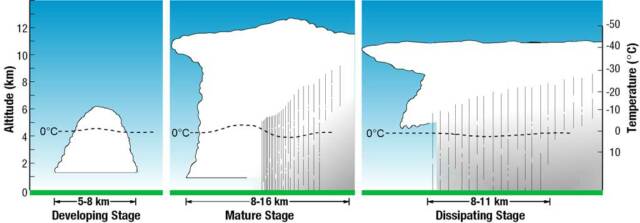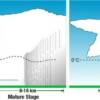© 2010 Naturesfury.net



What is a thunderstorm?
A thunderstorm is a rain shower during which you hear thunder. Since thunder comes from lightning, all thunderstorms have lightning. A thunderstorm is classified as "severe" when it contains one or more of the following: hail three-quarter inch or greater, winds gusting in excess of 50 knots (57.5 mph), tornado.
What is known?
An average thunderstorm is 15 miles in diameter and lasts an average of 30 minutes. At any given moment, there are roughly 2,000 thunderstorms in progress around the world. It is estimated that there are 100,000 thunderstorms each year. About 10% of these reach severe levels.
How does a thunderstorm form?
Three basic ingredients are required for a thunderstorm to form: moisture, rising unstable air (air that keeps rising when given a nudge), and a lifting mechanism to provide the "nudge."
The sun heats the surface of the earth, which warms the air above it. If this warm surface air is forced to rise -- hills or mountains, or areas where warm/cold or wet/dry air bump together can cause rising motion -- it will continue to rise as long as it weighs less and stays warmer than the air around it. As the air rises, it transfers heat from the surface of the earth to the upper levels of the atmosphere (the process of convection). The water vapor it contains begins to cool, releasing the heat, and it condenses into a cloud. The cloud eventually grows upward into areas where the temperature is below freezing. Some of the water vapor turns to ice and some of it turns into water droplets. Both have electrical charges. Ice particles usually have positive charges, and rain droplets usually have negative charges. When the charges build up enough, they are discharged in a bolt of lightning, which causes the sound waves we hear as thunder
The Thunderstorm Life Cycle
Thunderstorms have a life cycle of three stages: The developing stage, the mature stage, and the dissipating stage.
Thunderstorm FAQs
What Is A Supercell?
Are There Winter Thunderstorms?
The developing stage of a thunderstorm is marked by a cumulus cloud that is being pushed upward by a rising column of air (updraft). The cumulus cloud soon looks like a tower (called towering cumulus) as the updraft continues to develop. There is little to no rain during this stage but occasional lightning. The developing stage lasts about 10 minutes.
The thunderstorm enters the mature stage when the updraft continues to feed the storm, but precipitation begins to fall out of the storm, and a downdraft begins (a column of air pushing downward). When the downdraft and rain-cooled air spreads out along the ground it forms a gust front, or a line of gusty winds. The mature stage is the most likely time for hail, heavy rain, frequent lightning, strong winds, and tornadoes. The storm occasionally has a black or dark green appearance.
Eventually, a large amount of precipitation is produced and the updraft is overcome by the downdraft beginning the dissipating stage. At the ground, the gust front moves out a long distance from the storm and cuts off the warm moist air that was feeding the thunderstorm. Rainfall decreases in intensity, but lightning remains a danger.
Click image to enlarge
Image Courtesy of NOAA
Why do some thunderstorm have a greenish hue?
Why doesn't the west coast of the U.S. experience more thunderstorms?
Why does the sky sometimes turn orange after a thunderstorm?
Why are some clouds darker than others?
What Is SKYWARN?
SKYWARN is a National Weather program that is run by and coordinated by the NWS. It was a concept developed in the early 1970's that was intended to promote a cooperative effort between the National Weather Service and its communities. The emphasis of the effort is often focused on the storm spotter, a volunteer who takes a position near their community and reports wind gusts, hail size, rainfall, and cloud formations that could signal a developing tornado. Another part of SKYWARN is the receipt and effective distribution of NWS information.


